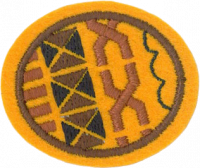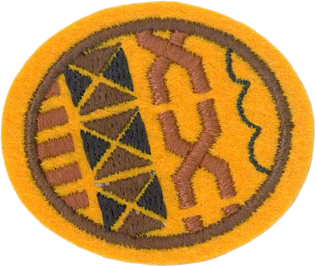|
|
| (3 intermediate revisions by 2 users not shown) |
| Line 1: |
Line 1: |
| − | <languages /><br />
| + | {{HonorSubpage}} |
| − | <noinclude></noinclude>
| |
| − | {{honor_desc | |
| − | |stage=00
| |
| − | |honorname=Vestidos de Tapa
| |
| − | |skill=1
| |
| − | |category=Artes domésticas
| |
| − | |authority=Asociación General
| |
| − | |insignia=Tapa_Cloths_Honor.png
| |
| − | }} | |
| − | | |
| − | | |
| − | <noinclude></noinclude>
| |
| | <section begin="Body" /> | | <section begin="Body" /> |
| | {{ansreq|page={{#titleparts:{{PAGENAME}}|2|1}}|num=1}} | | {{ansreq|page={{#titleparts:{{PAGENAME}}|2|1}}|num=1}} |
| Line 19: |
Line 7: |
| | {{clear}} | | {{clear}} |
| | | | |
| − | Nowadays tapa is still often worn on formal occasions such as weddings. Another use is as blanket at night. It is also highly prized for its decorative value and is often used as a decorative wall hanging. In Tonga a family is considered poor, no matter how much money they have, if they do not have any tapa in stock at home ready to give as a gift at weddings, funerals and so forth. A tapa given as a gift by a chief or even the royal family is considered highly valuable.
| + | {{clear}} |
| | | | |
| | <noinclude></noinclude> | | <noinclude></noinclude> |
| Line 33: |
Line 21: |
| | {{clear}} | | {{clear}} |
| | | | |
| − | *The cloth is glued together into bigger pieces - with tapioca root or other ways
| + | {{clear}} |
| − | *The patterns beaten into (or not) the cloth
| |
| − | *The dyes used
| |
| | | | |
| | <noinclude></noinclude> | | <noinclude></noinclude> |
| Line 41: |
Line 27: |
| | {{ansreq|page={{#titleparts:{{PAGENAME}}|2|1}}|num=3}} | | {{ansreq|page={{#titleparts:{{PAGENAME}}|2|1}}|num=3}} |
| | <noinclude></noinclude> | | <noinclude></noinclude> |
| − | <!-- 3. Know the trees used for making tapa cloth in your area. --> | + | <!-- 3. Conocer los árboles utilizados para la elaboración de tela Tapa en su área. --> |
| − | Originally, tapa cloth was most likely made from the bark of the Dye-fig (''Ficus tinctoria''), endemic to Oceania. Sometime in history during the voyages of migration, the paper mulberry tree (''Broussonetia papyrifera'') was introduced from Southeast Asia. The bark of the paper mulberry is much better suited to making tapa cloth, and so severely curtailed the use of the Dye-fig.
| |
| | | | |
| − | Many other trees provide the tools and dyes to make the tapa cloth. They vary by island, but traditionally include:
| + | {{clear}} |
| | | | |
| − | *Ironwood for the mallet used to beat the cloth.
| + | {{clear}} |
| − | *Coconut fiber used under the logs as shock absorbers
| |
| − | *Coconut fiber used to make patterns for transfer to cloth
| |
| − | *various hardwood to make the anvil
| |
| − | *Tree bark used to make the dye
| |
| | | | |
| − | See the videos for specifics
| + | {{clear}} |
| | | | |
| | <noinclude></noinclude> | | <noinclude></noinclude> |
| Line 58: |
Line 39: |
| | {{ansreq|page={{#titleparts:{{PAGENAME}}|2|1}}|num=4}} | | {{ansreq|page={{#titleparts:{{PAGENAME}}|2|1}}|num=4}} |
| | <noinclude></noinclude> | | <noinclude></noinclude> |
| − | <!-- 4. Explain the following: --> | + | <!-- 4. Explicar lo siguiente: --> |
| | | | |
| | <noinclude></noinclude> | | <noinclude></noinclude> |
| | {{ansreq|page={{#titleparts:{{PAGENAME}}|2|1}}|num=4a}} <!--T:6--> | | {{ansreq|page={{#titleparts:{{PAGENAME}}|2|1}}|num=4a}} <!--T:6--> |
| | <noinclude></noinclude> | | <noinclude></noinclude> |
| − | As Tonga is the country where tapa is still a part of daily life, the following description is given for that country. Although on other islands the overall process is about the same, there still might be several smaller or larger differences.
| |
| | | | |
| − | In Tonga ''hiapo'' is the name given to the paper-mulberry tree. People have bunches of them growing in a corner of their plantations. They are cut and brought home where the first task is to strip the bark from the trees. The strips are about hand wide and person long. The wood so left over is named ''mokofute''. The bark consists of 2 layers. In the next step the outer bark is to be scraped or split off from the inner bark. This work is called ''ha'alo''. The outerbark is discarded, the innerbark, named ''tutu'' or ''loututu'', is left over. It is first dried in the sun before being soaked.
| + | {{clear}} |
| | | | |
| − | After this, the bark is beaten on a wooden ''tutua'' anvil using wooden mallets called ''ike''. In the beating the bark is made thinner and spread out to a width of about 25 cm. This phase of the work is called ''tutu'' (or ''tutua''). The mallets are flat on one side and have coarse and fine grooves on the other sides. First the coarse sides are used, and towards the end of the work the flat side (''tā-tuʻa''). The continuous "thonk" beats of the tapa mallet is still a normal sound in the Tongan villages. If several women work together they can make a concert out of it. In that case there might be one who ''tukipotu'', beats the end of the ''tutua'' to set the rhythm.
| + | {{clear}} |
| | | | |
| − | When the strips are thin enough, several strips are taken together and beaten together into a large sheet. Some starch from the ''kumala'', or ''manioke'' may be rubbed on places which are unwilling to stick. This part of the work is called ''ʻopoʻopo'', the glue is called ''tou'' and the resulting sheet of tapa is called ''fetaʻaki''. It then consists of two layers of strips in perpendicular direction, the upper one called ''lauʻolunga'' and the lower one ''laulalo''. A knife or sharp shell named ''mutu'' is used to trim the edges, and the pieces fallen off in this process are called ''papanaki''. When the white fetaʻaki is smoked brown, it is called ''sala''.
| + | {{clear}} |
| | | | |
| − | Often the women of a whole village work together on a huge sheet of tapa. A donation to the church or their chief at an important occasion. Such sheets are about 3 meters wide and 15, or 30, or sometimes even 60 meters long. The 15 meter pieces are called ''launima'' (meaning: five-sheet, because the sheet is 5 squares), and the 30 meter pieces are called ''lautefuhi''.
| + | {{clear}} |
| | | | |
| | <noinclude></noinclude> | | <noinclude></noinclude> |
| Line 78: |
Line 58: |
| | <noinclude></noinclude> | | <noinclude></noinclude> |
| | | | |
| − | The ''fetaʻaki'' is almost always painted. It then becomes ''ngatu'', the Tongan word for the final product. The painting is done over the whole length, but only the central 2.5 meter in the width direction. On both sides there is an unpainted border of about 20 cm wide, which is called the ''tapa'' (in Tonga). In order to paint it, the sheets are first put over a huge wooden drum covered with stencils or ''kupesi''. These stencils are made from coconut front midribs (or any other sticks of a few millimeter thick). These stencils are made in the pattern which will be used. There are a handful of standard ''kupesi'' designs, like the 'Pine road' (the road from the palace to the royal cemetery), or the 'Shield of Tonga', or the 'Lion' (the king), or the 'Dove' (the king as ruler), and more abstract figures like the 'Manulua' (2 birds).
| + | {{clear}} |
| | | | |
| − | The tapa sheet is put over the drum and the women now rub with force a dabber with some brown paint (made from the ''koka'' tree ''(Bischofia javanica))'' over the sheet. This work is called ''tataʻi''. Where they rub over a rib of the ''kupesi'' more paint will stick to that position while very little will stick elsewhere. In this way the basic pattern is put on the sheet. Once a part is done, they lift up the sheet and proceed to the next strip and so forth. Only when the whole sheet has been preprocessed, then it will be spread out on the ground and with a brush (made from ''Pandanus'' seeds) the women will accentuate the faintly visible marks with some more generous paint, this time made from the ''tongo'', the mangrove ''(Rhizophora mangle)''. Both ''koka'' and ''tongo'' paint are always brown, but the latter is much darker. Black is not used in Tonga, although it is characteristic for Fiji.
| + | {{clear}} |
| | | | |
| − | It is customary that during the paint process lines are drawn on the ''ngatu'' along the width every 45 cm or more. The ''kupesi'' too are made to the size that they will fit in the divisions thusly made. Such a division is known as ''langanga'' and they are numbered (on the blank ''tapa'') from one to as many as needed for the whole length. When a smaller piece of ngatu is needed, the sheet is cut along a ''langanga'' division. A 4 to 6 ''langanga'' piece is called ''folaʻosi''. An 8 piece is ''fātuua'', while a 10 ''langanga'' piece of ''ngatu'' is known as ''toka hongofulu''. Less common are the double ''fātuua'', named ''fātufā'' or double of that again, the ''fātuvalu''.
| + | {{clear}} |
| | | | |
| − | These are the traditional ''ngatu'', as evidenced by the extensive vocabulary used (still many more terms exist). Nowadays for the tourist trade other sizes and designs can be made as well done.
| + | {{clear}} |
| | | | |
| | <noinclude></noinclude> | | <noinclude></noinclude> |
| Line 91: |
Line 71: |
| | {{ansreq|page={{#titleparts:{{PAGENAME}}|2|1}}|num=5}} | | {{ansreq|page={{#titleparts:{{PAGENAME}}|2|1}}|num=5}} |
| | <noinclude></noinclude> | | <noinclude></noinclude> |
| − | <!-- 5. Make a collection of a number of different types of tapa cloth designs and outline the purpose for which they were used. --> | + | <!-- 5. Hacer una colección de una serie de diferentes tipos de diseños de telas Tapa y desglosar el propósito del por qué fueron empleados/utilizados. --> |
| | | | |
| − | This is part of the "do" section of the honor. Enjoy collecting the cloth samples. You might try craft or traditional markets, or if you live outside the an area where tapa cloth is made, look on the internet.
| + | {{clear}} |
| | | | |
| | <noinclude></noinclude> | | <noinclude></noinclude> |
| | {{CloseReq}} <!-- 5 --> | | {{CloseReq}} <!-- 5 --> |
| | <noinclude></noinclude> | | <noinclude></noinclude> |
| − | ==References== | + | ==Referencias== |
| − | # [http://www.ebay.com/gds/polynesian-tapa-barkcloth-the-cloth-of-island-kings/10000000001650920/g.html Guide to Tapa Cloth]
| |
| − | # The definitive [http://amzn.to/14eP2Yk book on Tapa cloth]
| |
| − | # [http://www.magsq.com.au/_dbase_upl/Education%20sheets.pdf PDF with info and discussion questions]
| |
| − | # A clear video of the [http://www.youtube.com/watch?v=zdHOf1Q6GEE tapa process]
| |
| − | # [http://www.youtube.com/watch?v=7umj7aRBY9s Tapa making on Pitcairn Island]
| |
| | <noinclude></noinclude> | | <noinclude></noinclude> |
| − | [[Category:Adventist Youth Honors Answer Book|{{SUBPAGENAME}}]]
| + | {{CloseHonorPage}} |
| − | <section end="Body" />
| |


